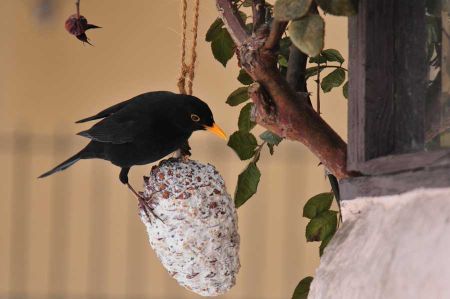A blackbird tries its hand at the tits dumplings
- Written by Portal Editor
For a long time now as much snow is quite rare nowadays, the thick layer of snow also messed up the lives of many animals, including "our" blackbird, which almost belongs to the farm, which now delights us again with a lot of singing, hardly that the snow was getting less.
Basically blackbirds are flexible and adaptable omnivores, but depending on at least small amounts of animal food throughout the year, so they are not really vegetarians.
The blackbird is probably the most versatile fruit eater among the thrush species; However, it rigorously avoids the fruits of the white berry mistletoe with their viscous contents. The proportion of berries and fruits from ornamental trees is comparatively high. The fruits are mainly selected according to the sequence of ripening and the sugar content. The proportion of fleshy fruits reaches its peak from October to November, during which time there can be large accumulations of blackbirds in vineyards and orchards.
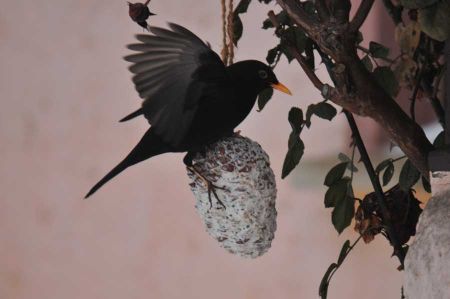 But when animal food is scarce or can only be obtained with a disproportionately large amount of effort, berries and fruits play a bigger role. Even during the cold season we were able to observe again and again how “our” blackbird was feeding on our privet berries. The berries of the privet are poisonous, consumption can lead to nausea, vomiting, diarrhea and abdominal pain in people, our blackbird seemed to taste them. We cannot confirm whether this effect also occurs in birds when a larger amount has been eaten. Our experience only relates to the cutting of the privet planted as a hedge, because skin contact when cutting the plant can lead to skin irritation, the so-called privet eczema.
But when animal food is scarce or can only be obtained with a disproportionately large amount of effort, berries and fruits play a bigger role. Even during the cold season we were able to observe again and again how “our” blackbird was feeding on our privet berries. The berries of the privet are poisonous, consumption can lead to nausea, vomiting, diarrhea and abdominal pain in people, our blackbird seemed to taste them. We cannot confirm whether this effect also occurs in birds when a larger amount has been eaten. Our experience only relates to the cutting of the privet planted as a hedge, because skin contact when cutting the plant can lead to skin irritation, the so-called privet eczema.
But now back to our blackbird
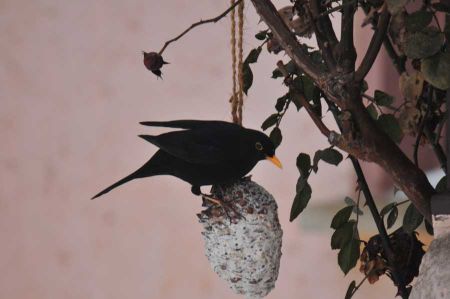 The main components of the blackbird's animal diet are earthworms and beetles up to the size of the cockchafer, snails, leeches, millipedes, spiders and various insect stages are also regularly used. In addition to numerous other invertebrates, the food spectrum also includes smaller vertebrates, including lizards, tail and frog aches, mice and shrews and, in exceptional cases, snakes. Blackbirds fishing have also been observed. If there is a lack of food, smaller insects such as aphids are also used as substitute food.
The main components of the blackbird's animal diet are earthworms and beetles up to the size of the cockchafer, snails, leeches, millipedes, spiders and various insect stages are also regularly used. In addition to numerous other invertebrates, the food spectrum also includes smaller vertebrates, including lizards, tail and frog aches, mice and shrews and, in exceptional cases, snakes. Blackbirds fishing have also been observed. If there is a lack of food, smaller insects such as aphids are also used as substitute food.
But what to do when all the areas in the area are covered with 60 - 80 centimeters of snow and even the berries of the privet hedge are barely to be found?
We had hung up some tit rings to help the animals with the snow depth at least with some food for the days. Initially no chance for our blackbird, because when there is a lack of food, blackbirds use winter feeding in the settlement area, seeds are also consumed in larger quantities, but like the seeds of ingested fruits, these are hardly digested. Blackbirds then also look for food in waste.
The extraordinary feeding and flight behavior of our blackbird
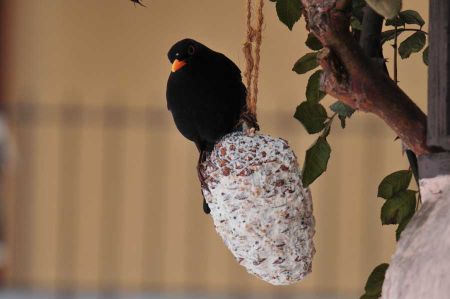 There have been many observations of unusual eating habits in blackbirds, but the first attempts to approach the tit rings and the coconut, which is fed with bird seed, a very popular place of entry for the great great tits and blue tits, but also for the wren, were particularly interesting was more intent on the seeds in the rose bush. We were able to observe that our blackbird stayed on the ground below the tit rings to search for food, then moved by hopping a short distance and then pausing motionless, with the blackbird holding its head crooked and fixing a certain point, and then quickly with it to strike the beak.
There have been many observations of unusual eating habits in blackbirds, but the first attempts to approach the tit rings and the coconut, which is fed with bird seed, a very popular place of entry for the great great tits and blue tits, but also for the wren, were particularly interesting was more intent on the seeds in the rose bush. We were able to observe that our blackbird stayed on the ground below the tit rings to search for food, then moved by hopping a short distance and then pausing motionless, with the blackbird holding its head crooked and fixing a certain point, and then quickly with it to strike the beak.
Again and again the attempts to do the same as the tits and to fly directly to the food source. And indeed.
After the tits had eaten at least a certain platform, the next approach of our blackbird worked almost perfectly. The landing was still a bit bumpy, and the release of the grains on the swaying platform still took getting used to, but it was fun to follow the learning process and discover that it worked better and better. A real pleasure that also led to the photos.
Blackbird song - the musically highest songbird in Central Europe
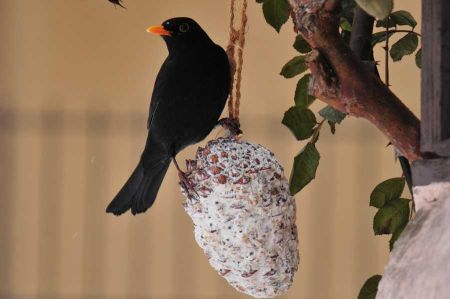 It has often been observed that the blackbird song comes very close to our understanding of music. So it is not surprising that the blackbird song, in contrast to many other sounds made by birds, can be reproduced quite well in the notation system. There are some considerations of singing from a musicological point of view; the composer and conductor Heinz Tiessen has dealt with them particularly intensively. For him the blackbird was "the musically highest songbird in Central Europe". The range of the blackbird's voice is considerably more than an octave. In contrast, the nightingale, which is often praised for its singing, makes less of its greater musical possibilities; Chromatics and beyond that into the key and harmonic inconceivable. ”Olivier Messiaen (1908–1992), a French composer, had a similar predilection for blackbird singing. He even dedicated the piece of music “Le Merle noir”, a chamber music piece for flute and piano, to the blackbird.
It has often been observed that the blackbird song comes very close to our understanding of music. So it is not surprising that the blackbird song, in contrast to many other sounds made by birds, can be reproduced quite well in the notation system. There are some considerations of singing from a musicological point of view; the composer and conductor Heinz Tiessen has dealt with them particularly intensively. For him the blackbird was "the musically highest songbird in Central Europe". The range of the blackbird's voice is considerably more than an octave. In contrast, the nightingale, which is often praised for its singing, makes less of its greater musical possibilities; Chromatics and beyond that into the key and harmonic inconceivable. ”Olivier Messiaen (1908–1992), a French composer, had a similar predilection for blackbird singing. He even dedicated the piece of music “Le Merle noir”, a chamber music piece for flute and piano, to the blackbird.
Blackbird motifs also inspired Richard Strauss, with the Rosenkavalier he captured the blackbird song quite naturally. At the beginning of the first act, while the curtain rises, it is performed by the first clarinet. Real blackbird singing was added to the original recording of Paul McCartney's "Blackbird", but there the blackbird only serves as a substitute and embodies a woman.
Finally, something macabre from the past
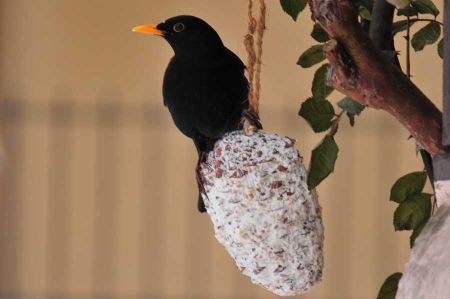 The Romans fattened blackbirds in large bird houses because blackbird meat was considered very tasty. Traditional Corsican cuisine includes pâté de merle, a blackbird pate. Blackbirds were also very popular as housebirds because of their song. It was considered beneficial to catch older blackbirds in order to enjoy the song "in all its purity". Hand-raised blackbirds, on the other hand, were taught melodies. Blackbirds were also popular as decoys on the Vogelherd. In contrast to hand-reared specimens, captured blackbirds are never completely tame and, moreover, behave very aggressively towards other birds, especially towards other birds, almost like us humans unfortunately too often!
The Romans fattened blackbirds in large bird houses because blackbird meat was considered very tasty. Traditional Corsican cuisine includes pâté de merle, a blackbird pate. Blackbirds were also very popular as housebirds because of their song. It was considered beneficial to catch older blackbirds in order to enjoy the song "in all its purity". Hand-raised blackbirds, on the other hand, were taught melodies. Blackbirds were also popular as decoys on the Vogelherd. In contrast to hand-reared specimens, captured blackbirds are never completely tame and, moreover, behave very aggressively towards other birds, especially towards other birds, almost like us humans unfortunately too often!
Please read as well:
Tea - preparation rituals as different as the dishes
A detour with consequences - Passage of the Lake Dojran
